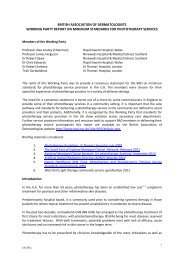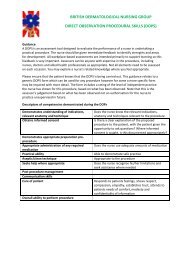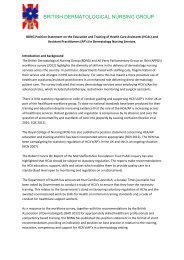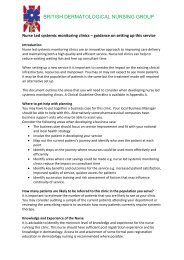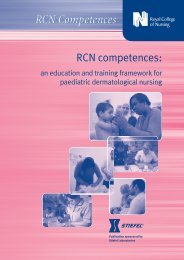Improving outcomes for people with skin tumours including melanoma
Improving outcomes for people with skin tumours including melanoma
Improving outcomes for people with skin tumours including melanoma
Create successful ePaper yourself
Turn your PDF publications into a flip-book with our unique Google optimized e-Paper software.
• lymphoedema therapists<br />
• pharmacists.<br />
Table 3. Example of activities in a rolling programme of audit<br />
<strong>Improving</strong> Outcomes <strong>for</strong><br />
People <strong>with</strong> Skin Tumours<br />
<strong>including</strong> Melanoma<br />
Organisation of <strong>skin</strong><br />
cancer services<br />
• Audit of all <strong>skin</strong> cancers to be presented annually, <strong>including</strong><br />
those not discussed at the MDT<br />
• Audit of all <strong>skin</strong> cancer excision margins according to<br />
published guidelines<br />
• Waiting times according to national targets (see section on<br />
‘Cancer waiting times targets’)<br />
• Proportion of cases actually reviewed by the MDT according<br />
to criteria listed<br />
• Critical incidents where treatments were judged to be<br />
outside recommended network guidelines – network<br />
meetings should take place annually to review such<br />
incidents<br />
3<br />
• Audit of histopathology reporting times<br />
• Audit of Mohs surgery activity<br />
• Audit of clinical trial entry<br />
The specialist <strong>skin</strong> cancer multidisciplinary team<br />
(SSMDT)<br />
Patients <strong>with</strong> invasive <strong>skin</strong> cancer associated <strong>with</strong> a greater risk or<br />
rarity should be managed by SSMDTs. These teams should be<br />
established in larger hospitals, usually cancer centres, plastic surgery<br />
centres or other specialist tertiary services of relevance to <strong>skin</strong> cancer<br />
and should provide a service <strong>for</strong> a minimum population of 750,000.<br />
These teams can also serve as the LSMDT <strong>for</strong> the local population.<br />
The teams should include appropriate non-surgical oncology support.<br />
Specific cases <strong>for</strong> referral to the SSMDT are set out in Table 4. Where<br />
patients meeting criteria <strong>for</strong> SSMDT are identified by dermatologists<br />
that attend LSMDTs, review at the LSMDT may take place on the basis<br />
that referral to the SSMDT is immediate and should not be dependent<br />
upon the LSMDT review.<br />
Guidance on cancer services: <strong>skin</strong> <strong>tumours</strong> <strong>including</strong> <strong>melanoma</strong><br />
55




